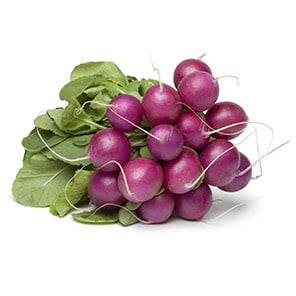All About Radish
Fast-growing radishes are the first field-grown salad crop of the British growing year. Available from mid-April radishes are harvested all the way through until late October (depending on the weather).
1m
28 Days
40 million
23rd April
UK growers harvest over half a billion radishes every year from April to October
Growing
The largest proportion of the British radish crop is grown on farms in Norfolk, where the Scott Watson and his team have specialised in radish crops for well over a decade.
Scott manages one of the biggest areas dedicated to growing radishes in the UK at Feltwell in West Norfolk. Radish growing started at Feltwell in the 1980’s when growers in the region were looking for crops which suited the rich black fen soil which is naturally very fertile.
Radishes grow well in a lot of different climates. They are an ideal crop for the East of England as the Fenland peats retain their moisture, which reduces the need for irrigation. It also preserves the local area’s water supply in one of the driest regions in the country. The soil also has very few stones which is important because it minimises the damage to radishes at harvest
The busiest time of year is early summer from April/May onwards. Radishes are the UK’s first open field salad crop to harvest, starting on St George’s Day, 23rd April.
The green leaves start to sprout in late March and the challenge is to make sure the crop is not caught by any late frosts. The progress of the crop growing is weather dependent and hinges on whether the Spring is mild, dry, cold, wet or a combination of any of these. This continues into the summer as each crop of radishes matures.
The weather plays its part in the heat of the radishes. The more heat, the more peppery the radish.
Meet the grower: Scott Watson
Radishes have been grown at Feltwell in Norfolk since the 1980’s. I took over as farm manager in 2005 and have been growing radishes ever since then.
My busiest time of year is early Summer, from May onwards – although it depends on the weather – and the orders of course!
On an average day at the beginning of the season, the most important thing for me to do is keep an eye on the emerging crops, make sure we’re not caught out by any late frosts. I usually start to see the green leaves appear in the ground in late March and enjoy tending to and watching the plants mature until they’re ready to produce radishes in April ready for harvest. So much is weather dependent – a lot hinges on whether we have a mild spring or a lot of cold rain.
Radishes grow pretty well in a lot of climates, but the Fenlands round here are exceptionally well suited, being a good fertile peaty soil, with good moisture retention. This means we don’t need to irrigate so often, which preserves the area’s water supplies – important in the Fens, which is one of the driest regions in the country! Also, the soil is soft with very few stones, which can damage the radishes during growth and at harvest, so we get a nice consistent skin finish to our radishes.
We work about 340 hectares – that’s cropping area, not the actual farm, as we might get more than one crop from the same field in a season. We sell upwards of 30 million packs of radishes per year. Each pack has an average weight of c.200g – so this averages out as about 6,000 tonnes of radishes.
The primary radish varieties that we grow are the traditional red globe radish, and we also grow a small amount of elongated French breakfast and purple globe radishes which go into mixed radish pack. In recent years we have experimented with some oriental varieties of radish such as the pink centred Watermelon radish. These varieties aren’t as used to our weather so are only really available between August and October. I will continue to trial different varieties, and to work on improving the existing ones. Trailing a variety doesn’t mean that we will go ahead and grow it commercially, but it will add to our knowledge which will help us perfect how we grow our staple crops.
A very rewarding aspect of my job is that growing one of the earliest outdoor salad crops of the year, I get to see the results of all that hard winter work sooner than other farmers. On the flipside, a challenging aspect, common to all growers, is that we are at the mercy of the weather and it can be very frustrating when a late frost undoes all your good work.
If I wasn’t growing radishes, I’m sure I would still be doing something related to the land – maybe training champion sheepdogs! I started my working life as a shepherd, and I still work with my dogs when I’ve got time.
As for eating radishes, I think that my favourite variety for just snacking on is French Breakfast. I often eat mine straight from the field, but they’re very good the traditional way with butter and salt, and brown bread.
Radish Varieties
Radishes are grown and enjoyed across the world, and there are lots of varieties. There are many differences; size, colour, flavour and the length of time they take to mature.
Of course wild radishes came first. Wild radishes – also known as sea radishes, white charlock or jointed charlock – are most recognisable by their white/purple/yellow/orange flowers. Cultivated radishes are enjoyed because for their peppery flavour and crunchy texture. The most popular types of radishes are:
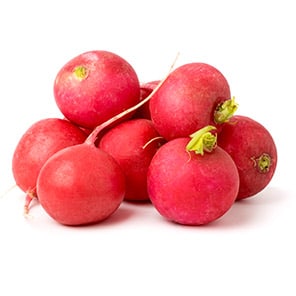
The purple round radish is the same shape and size as its more common round red cousin. Like red radishes, purple are are at their best firm and crisp and they are sometimes a bit cooler than red. This can make them easier for kids to try. You’ll see purple radishes in mixed packs in shops from the start of the British season on 23rd April. Purple foods are high in natural compounds called anthocyanins which are understood to offer health benefits such as reduction in blood pressure and boosting your immune system.
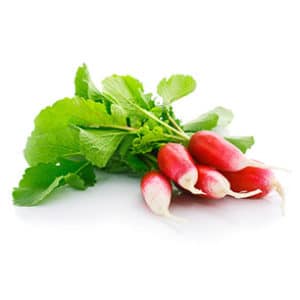
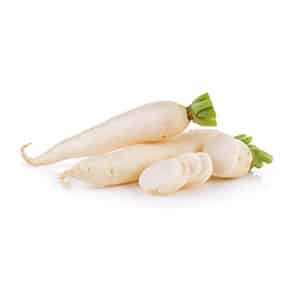
Daikon is a winter radish which is slower growing and larger than spring radishes. It has a sweet and lightly spicy flavour, milder than a red round, and is very crunchy and juicy. Daikon can be thinly sliced to be served raw or for pickling; diced for cooking or grated for use in baking. Despite being very low-calorie it is nutrient dense – full of fibre, Vitamin C, folate, potassium, calcium and magnesium.
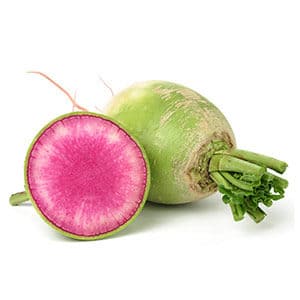
The watermelon radishes Chinese name is Xin Le Mei or Shinmirei, which translates to ‘in one’s heart beautiful’. The Watermelon radish can be served raw, thinly sliced to show off its vibrant colour, pickled or cooked. In Chinese cuisine, they are often cooked with seafood because they add sweetness and reduce the fishy flavour. Both the root and greens of a watermelon radish are a great source of Vitamin C, particularly when eaten raw.
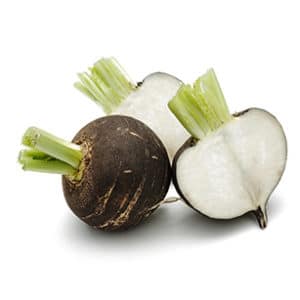
Black radish can be eaten raw, thinly sliced or shredded. A small amount of radish should be mixed with tart and sweet ingredients to balance flavours. They can also be roasted, braised, fried or sauteed. It you prefer a milder heat then peel them.
Black radish was used in the ancient folk medicine of Asia, Africa and Mexico and was thought to be particularly good for stimulation of bile function.
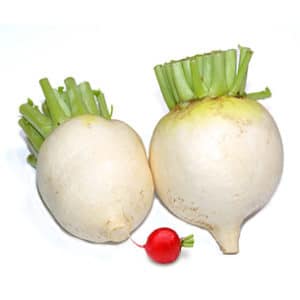
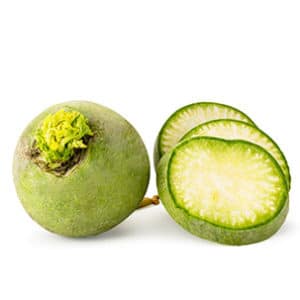
The crisp texture of Green Meat means it’s especially good when served raw – sliced thinly and served in sandwiches and salads, as a condiment with sushi or within a slaw. Green Meat radishes were used in traditional Chinese medicine, particularly thought to promote respiratory health.
Cooking & Eating
Radishes are sometimes sold with their leaves on, tied into bunches, or ready-topped in bags. The leaves can be used in salads but should be used immediately otherwise they begin to wilt. The radishes themselves should be firm and crisp, and kept in the salad drawer of your fridge where they should last for up to two weeks (always remove the leaves before storing).
Radishes are can eaten raw, on their own as snacks (delicious with a little butter and dipped into salt) or in salads and sandwiches. They can be cooked for a short time, so can be added into stir-fries for the last couple of minutes of cooking, or why not try sprinkling chopped radish onto fresh vegetable soups as a healthy alternative to croutons.
Preparation
If you grow your own, wash gently to remove any soil. Trim off the tops and tails and slice, or cut into chunks. If eating with a dip, such as mayonnaise leave a little of the green stalk to act as a handle. For added crispness soak in iced water for an hour before use. The tops can be used in salads or cooked like other greens.
How to store radish
Always take off any leaves before you store them. The leaves can be enjoyed in salads if they are used as soon as they are cut off. Radishes should be kept in the fridge salad drawer where they will last up to 2 weeks.
Radish Facts
Radishes in film, radishes as wages, radishes in gold! Here are some fun facts about radishes around the world and through history.
In the novel ‘Gone with the Wind’ it was after attempting to eat a radish – the only food she could get – that a starving Scarlett O’Hara declared, “As God is my witness, I’ll never be hungry again.”
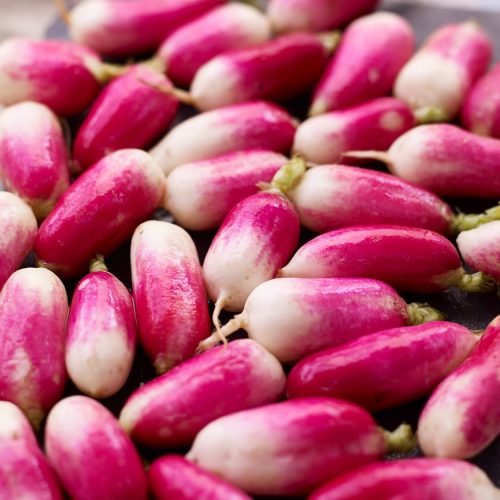
In Ancient Greece the radish was so revered that gold replicas were made of the vegetable and offered to the god Apollo. The Greeks served their radishes with honey and vinegar.
If you put all 40 million radish packs sold last year, end to end, the line would stretch for 10,000 km. That would take you from London to New Delhi where you could enjoy a famous Kashmiri Radish Curry.
Grown from seed radishes are fast growing and are ready for harvest in just 28 days. Sown in March, they are the first British outdoor salad crop to come into season in April.
In Oaxaca in Mexico, December 23rd is “The Night of the Radishes” (Noche de Rabanos). The festival features depictions of all kinds of subjects, including nativity scenes – all carved in radishes!
The radish found its way to England in the mid 16th century and into Shakespeare. “I do remember him at Clement’s Inn, like a man made after supper of a cheese-paring. When ‘a was naked, he was for all the world like a fork’d radish, with a head fantastically carved upon it with a knife.” King Henry IV. Part II. Act iii. Sc. 2.
A garden of radishes in your dreams means prosperous business and kind friends. Dreaming you are eating radishes, means your feelings will be hurt by someone’s thoughtlessness. A dream that you are planting radishes foretells that your heart’s desires will be happily realised.
Peter Rabbit enjoyed his radishes and famously ate a rather long variety known as the Long Scarlet in an illustration from the Beatrix Potter book.
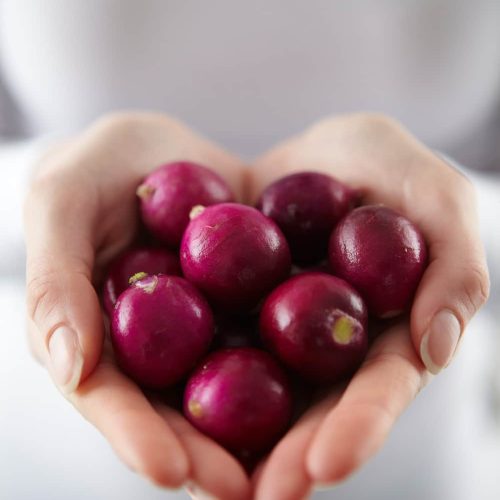
Radishes come in many colours, shapes and sizes. Red, purple, French Breakfast, Easter Egg, Watermelon or giant white Daikon and Mooli popular in Asian cookery.
Sakurajima radish can grow up to 3ft long, weighing 100lbs (45kg). Needless to say, you’re unlikely to see these in your local supermarket!
Always take off any leaves before you store them. The leaves can be enjoyed in salads if they are used as soon as they are cut off.
Radishes have been grown on the Norfolk Fens for more than 30 years. The light soil and low rainfall provide the perfect conditions
Radishes should be firm, crisp and kept in the fridge salad drawer where they will last up to 2 weeks.
Radishes were cultivated for thousands of years in China before being grown in Ancient Egypt and Greece.
Radishes, onions and garlic were paid as wages to the Egyptian labourers who built the Pyramids. Radish seeds were an important source of oil in Ancient Egypt before olive trees were introduced.
Radish education
Grow your own
Growing radishes in cardboard toilet roll tubes is a fun project you can do at home. In just a few weeks you can enjoy crispy home grown radishes without needing a garden!
Radish counting to 5
Lesson plan for nursery/reception age children to help them learn to count to five; children count radish pictures, use their fingers and begin to use marks on paper to recognize and represent numbers.
Maths activity pack
A maths activity pack for Year 1 students. These worksheets are focused on small numbers. Students should be able to count to 10, add and subtract numbers with totals up to 10.

